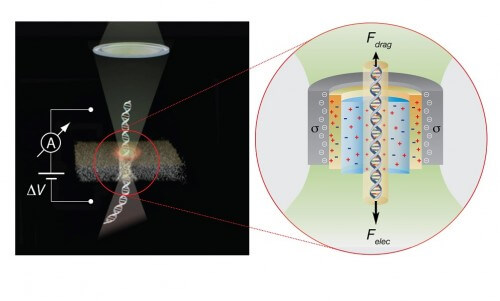Focusing laser light on tiny nanoholes will significantly improve the accuracy of DNA sequencing

The Technion researchers succeeded in developing a pioneering method based on nanoholes (holes measuring 5-2 nanometers) in solid state in silicon chips, for the purpose of developing a state-of-the-art technology for sequencing DNA molecules as they pass through them. This is what the prestigious scientific journal Nature Nanotechnology publishes.
"Inexpensive and very fast DNA sequencing will bring about a revolution in health services and biomedical research, and promote breakthroughs in drug development, preventive medicine and personalized medicine," says Professor Amit Meler from the Faculty of Biomedical Engineering. "By accessing the complete sequence of
The person's genome will allow the doctor to determine the likelihood that he will develop a specific genetic disease or that he will respond positively to certain medications."
For this purpose, Professor Meller invested a significant part of his time in the last decade in the development of the pioneering method. Now Professor Meller, together with a team of researchers from the Technion and Boston University, has discovered a simple way to improve the sensitivity, accuracy and speed of this method, thus making it a viable and even more useful option in DNA sequencing or in the characterization of small proteins such as ubiquitin in their normal, folded state.
In the online edition of Nature Nanotechnology, the team showed that focusing a green laser (a commercially available, low-power light source) on a nanohole increases the current near the walls of the hole, which is immersed in an electrolyte solution (salt water). When the current increases, it sweeps the electrolyte with it in the opposite direction to that in which the DNA samples enter. The flowing water becomes a barrier that slows down the passage of DNA in the hole (see figure). As a result, the nanosensors improve their resolution in reading the DNA as it crosses the hole and identify small proteins that cannot be detected by conventional means.
Professor Meller says: "The phenomenon we describe in the article - a surface charge created by light - makes it possible to instantly turn on and off the 'brakes' acting on individual biopolymers, such as DNA or proteins passing through the nanoholes. This dramatically improves the resolution of solid-state nanoholes, holes that can be easily incorporated into future nanohole-based DNA sequencing and protein detection technologies. Slowing down the DNA is essential for sequencing DNA and RNA using nanoholes, so the nanosensors may give us accurate information about what is passing through them."
"The goal is to hold the base-pairs (of the nucleotides) in the sensing space of the nanoholes so that they deliver the said information (that is, determine whether it is A, C, G or T)," says one of the authors of the article, Alison Squires - a student at Boston University. who also worked at the Technion and produced nanoholes in this research. "To succeed in the mission, the signal needs to be sufficiently different for each base. If the sample passes through the sensing area too quickly, it is difficult for the sensors to interpret the signal and correctly identify the protein."
Professor Meller and his team characterized the rate of increase in current in the presence of variable laser illumination and holes of different sizes. Their next goal is to investigate in more detail the mechanism underlying the increase in surface flow when the green laser is directed at a nanohole. This investigation is expected to lead to further improvement in sensitivity and accuracy in DNA sequencing.
